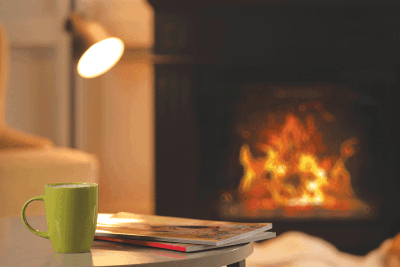METRO DETROIT — Autumn’s cool, crisp air is around the corner, which means many homeowners will soon want to cozy up by their fireplaces.
But before you decide to spark a fire, local fire experts have a few safety tips to keep in mind.
Fireplaces are often neglected when it comes to maintenance, so experts say it’s important to have a licensed chimney specialist inspect your fireplace each year.
“You always want to make sure that your chimney is inspected — and cleaned, if necessary — by a qualified professional,” said Susan McKelvey, communications manager for the National Fire Protection Association. “Obviously, it’s best if that is done before the start of the heating season.”
Inspections can assure there are no cracks or dislodged bricks that need to be repaired, and they can check for animal nests or other blockages that could prevent smoke from escaping.
Cleanings will help get rid of built-up soot and creosote — a tarlike substance that’s a byproduct of wood fires — that can spark a dangerous chimney fire.
Homeowners with gas-powered fireplaces should also hire a professional to check for hazards, such as leaks in the gas line.
Once you’re given the green light to use your fireplace, make sure you know how to open the flue, so smoke is drawn out of the house and clean air is drawn in. Cracking a window can also help with air quality.
Experts say to burn nothing in the fireplace except dry firewood or Chimney Safety Institute of America-accepted manufactured logs and to clean out all ash from previous fires before lighting a new one.
“You don’t want to burn other things, like trash, wrapping paper or newspaper because the byproduct of those burning materials can cause a buildup in the lining of your chimney, so you really just want to make sure that you put wood in your fireplace that’s designed for being burned,” McKelvey said.
“And always remember not to overload your fireplace with wood,” Rochester Fire Chief John Cieslik added. “We don’t want someone to put so much wood in the fireplace that it would fall out, so you also need to make sure there are screens in the fireplace to keep sparks from flying.
Although the mesmerizing glow of the flames can be enticing, children and pets should always be at least 3 feet away from the fireplace. A safety screen should be installed to reduce the risk of burns, and the area around the fireplace should be clear of anything that’s potentially flammable — including drapes, blankets, baskets, books and other decorative items.
“You want to make sure the area is clear of anything that can burn,” McKelvey explained.
Once you’ve gotten your fire roaring, remember to never leave it unattended and also make sure it’s completely out before going to bed or leaving the house.
“And it’s always a good time to check your fire extinguisher in your house to make sure it’s ready in the event that you would need it,” Cieslik said.
The U.S. Consumer Product Safety Commission estimates that fireplaces and chimneys are involved in an average of 15,800 fires per year, resulting in an average of 20 deaths and 50 injuries annually from 2017 to 2019.
Fire officials say dangerous home blazes can be prevented with a simple tool — a fire alarm.
“We always want people to test their smoke alarms and remember to replace their batteries,” Cieslik said.
Three out of every five home fire deaths result from fires in homes with no smoke alarms, according to the National Fire Protection Association. So it’s very important that you have smoke alarms — with the label of a reputable testing agency, like Underwriters Laboratories — in every bedroom and in the common areas on each floor of your home. All smoke alarms should be replaced every 10 years or sooner if they don’t respond properly when tested. When smoke alarms fail to operate, it is usually because batteries are missing, disconnected or dead.
Anything that burns fuel, such as a gas fireplace, can potentially become a source of carbon monoxide — an invisible, odorless gas that can kill — so fire officials say homeowners should also make sure to have CO detectors in their homes.
CO alarms should be installed in a central location outside each bedroom and on every level of the home. Just like smoke alarms, homeowners are advised to change the batteries, test and interconnect their carbon monoxide detectors, if possible, and make sure the vents for their gas appliances — like the fireplace, dryer, stove and furnace — are free and clear of snow or debris.
Cieslik also encourages the public to conduct a fire inspection within the home this fall, checking and replacing the batteries in their smoke detectors, going over the locations where they have multiple electrical devices plugged in and creating or updating the family’s emergency evacuation plan so everyone knows what to do in the event of a fire.
He suggests sleeping with bedroom doors closed, which serves as a barrier from smoke and fire, and having a family meeting place to help family members, and firefighters, account for those who are safe and those who might need rescuing.
“This is always a great time to take a look at your family’s evacuation plan so the whole family knows how to get out of the house, should there be an emergency, and to have your meeting point established, so that everyone heads to the same meeting point where they can be accounted for,” said Cieslik.
 Publication select ▼
Publication select ▼























